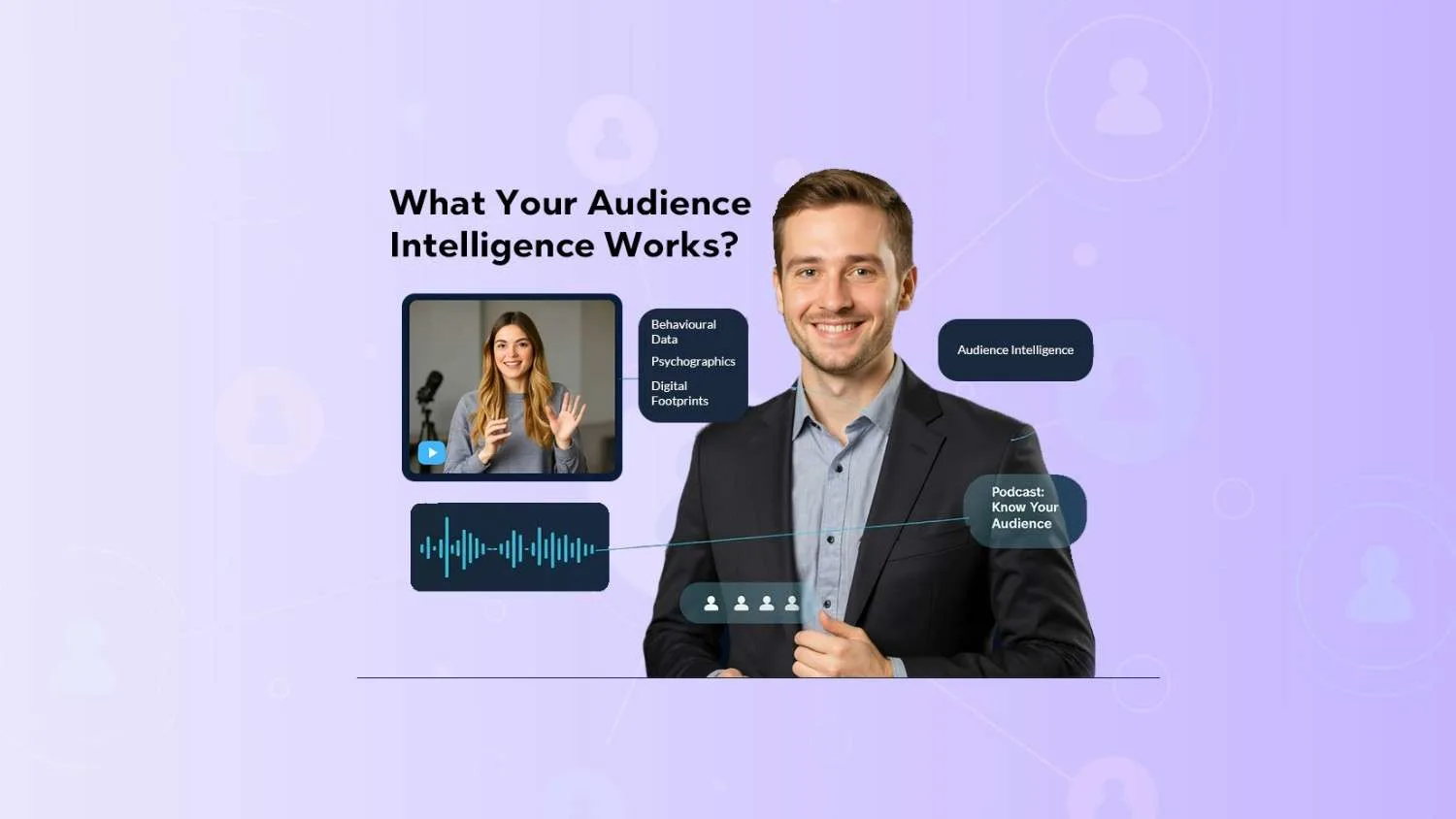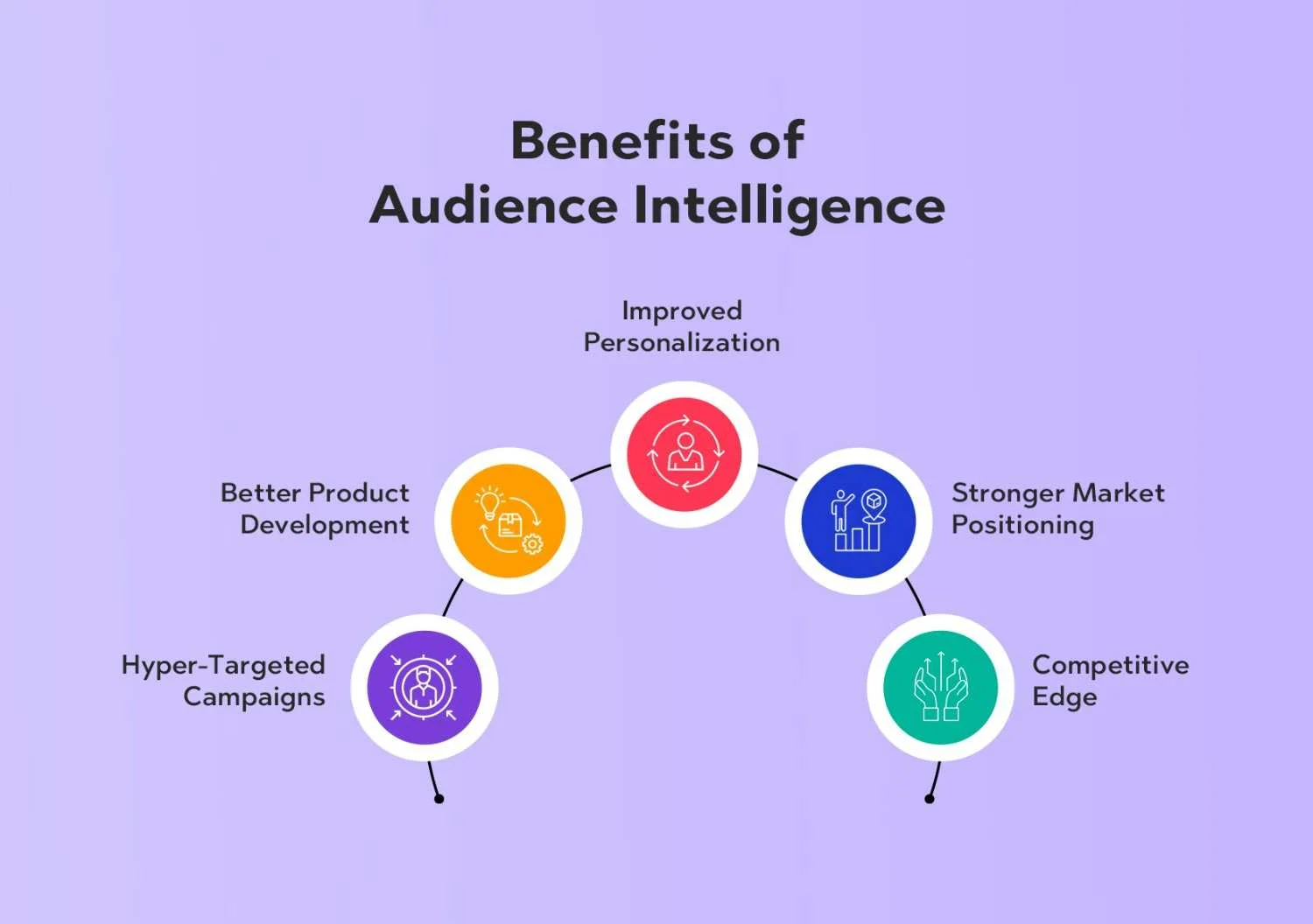Rahul Guleria
SEO Executive

In today’s digital-first world, knowing your audience isn’t a luxury-it’s a necessity. With data coming from every direction, understanding who your customers are, what they care about, and how they behave online is the foundation of a successful marketing strategy. That’s where audience intelligence comes into play.
Audience intelligence enables businesses to go beyond basic demographics, providing a clearer and deeper picture of their customers. It blends behavioural data, social insights, psychographics, and digital footprints to tell a story about what drives people’s choices. Whether you’re shaping a campaign, creating content, or launching a product, audience intelligence helps you make smarter decisions that resonate.
Let’s unpack this concept further to understand how it works and why it matters.
Put simply, audience intelligence is the process of collecting and analyzing data to understand the interests, behaviours, preferences, and motivations of a specific group of people. It’s not just about knowing the age or location of your audience-it’s about digging deeper to understand why they do what they do.
Unlike traditional analytics, which often focuses on surface-level metrics like page views or bounce rates, audience intelligence dives into:
For example, instead of just knowing your customer is a 35-year-old man living in Austin, Texas, audience intelligence might reveal that he’s a startup founder, follows sustainability influencers, and actively engages in conversations about renewable energy. This level of insight empowers you to tailor your messaging, content, and offers in ways that truly connect.
In essence, what is audience intelligence? It’s a modern, dynamic way of truly knowing your customer-not just as data points, but as real people.

To build a complete picture, audience intelligence blends multiple data layers:
These are the basics-age, gender, income, education level, and location. While foundational, demographics alone don’t provide a full understanding of your audience’s mindset.
Here’s where things get more interesting. Psychographics dive into beliefs, interests, values, lifestyles, and attitudes. This layer helps answer the why behind behaviours.
Audience intelligence tools track how people interact with digital platforms-what websites they visit, what content they like or share, and what search terms they use. These behaviours offer powerful clues about intent and interest.
By analyzing what people buy, how often they purchase, and what triggers their buying decisions, you can understand not just who your customer is, but when and why they’re ready to act.
Together, these elements form a comprehensive view of the audience-allowing brands to move from assumptions to evidence-based strategies.
So how does all this data come together to create actionable insights? Let’s break it down.
Audience intelligence tools gather data from diverse sources-social media conversations, CRM systems, website analytics, search queries, surveys, and even third-party platforms. These raw data points are the building blocks.
AI and machine learning technologies process the collected data, organize it, and match it across platforms. This step removes silos and connects the dots between different behaviours and audience segments.
The system identifies patterns and clusters, grouping similar audience members together based on shared characteristics-like values, interests, or buying behaviour. These segments are then profiled to build real-life personas.
Visual dashboards and analytics reveal trends, sentiment, influencer networks, and audience affinities in real time. Brands can use this to adapt quickly, personalize campaigns, or discover untapped market opportunities.
Harnessing audience intelligence unlocks a wealth of advantages:

With a granular understanding of your audience, you can craft ads and content that speak directly to their needs and values.
Customers today expect personalized experiences. Audience intelligence allows for dynamic messaging, product suggestions, and email content tailored to each segment.
Understanding what your audience wants-before they even ask-helps brands create relevant, demand-driven offerings.
You can identify white spaces in the market, reposition products, or uncover unmet needs.
By tapping into real-time audience sentiment and trends, brands stay ahead of competitors and adapt strategies faster.
If you're asking, what is audience intelligence really good for? The answer is everything from strategy and storytelling to customer service and innovation.
Audience intelligence isn’t just for marketers-it benefits sales, product development, customer service, and more. Here's how different teams can put it to work:
Learn what topics your audience cares about, what language they use, and which formats they prefer.
Audience intelligence allows for custom audience building and laser-focused ad targeting, reducing wasted ad spend.
Discover which voices your audience trusts, and partner with influencers who can authentically engage them.
Track how people feel about your brand in real time and understand what shapes their perceptions.
Map out where your customers come from, what channels they use, and what obstacles they face-enabling smoother, more effective journeys.
In short, the possibilities are vast. When you understand your audience at this level, every interaction becomes more intentional
Feature | Audience Intelligence | Traditional Market Research |
|---|---|---|
Speed | Real-time or near-instant | Weeks or months |
Scale | Millions of data points | Small sample sizes |
Data Sources | Social media, CRM, web, surveys | Focus groups, interviews, surveys |
Depth of Insight | Behavioural, emotional, network-based | Primarily self-reported data |
Cost | Cost-effective at scale | Often expensive |
While both have value, audience intelligence provides a more agile and scalable approach. It’s ideal for fast-paced digital environments where insights need to be timely and ongoing.
As powerful as it is, audience intelligence isn’t without its hurdles.
With GDPR, CCPA, and other regulations in place, companies must ensure they’re handling audience data ethically and legally.
Not all data is created equal. Inaccurate or outdated third-party data can lead to flawed insights.
Extracting meaningful insights from vast data sets requires the right tools-and often, skilled data analysts.
Brands must balance enthusiasm with responsibility, investing in trusted platforms and following best practices to ensure audience intelligence is both effective and compliant.
Ready to integrate audience intelligence into your strategy? Here’s how to begin:
1. Define Your Goals: Are you trying to improve ad performance, discover new audiences, or strengthen customer loyalty? Start with clear objectives.
2. Choose the Right Tools: Platforms like Audiense and SparkToro, offer specialized capabilities depending on your needs.
3. Collect and Enrich Data: Pull data from your website, social media, CRMs, and customer feedback. Use AI tools to make connections.
4. Analyze and Segment: Look for patterns, group your audience into personas, and explore behavioural insights.
5. Take Action: Apply what you learn to campaigns, messaging, product development, and customer service.
And remember-audience intelligence is not a one-time effort. It's an ongoing cycle of learning, adapting, and refining.
So, what is audience intelligence? It’s your competitive edge in a cluttered digital world. By moving beyond guesswork and assumptions, audience intelligence enables brands to build stronger relationships, craft more relevant experiences, and stay one step ahead.
As digital ecosystems evolve and customer expectations rise, audience intelligence becomes not just useful-but essential.
Want to see it in action? Explore our audience intelligence solutions and unlock the full potential of your customer data.
It’s the use of data to deeply understand your target audience’s behaviours, interests, and motivations-going beyond basic demographics.
It pulls data from social media, CRMs, websites, search queries, and surveys, then uses AI to analyze and visualize insights.
You gain improved targeting, better personalization, smarter content, and more competitive positioning.
Audience intelligence is faster, more scalable, and draws from digital behaviour, while market research relies on small samples and self-reporting.
Yes, many tools are accessible and scalable for businesses of all sizes.
Demographics, psychographics, social activity, web behaviour, and purchasing trends.
Yes, when compliant with GDPR, CCPA, and platform-specific policies.
By identifying trends, influencers, and topics that resonate with their audience.